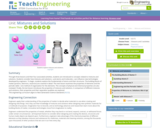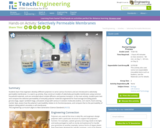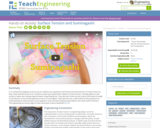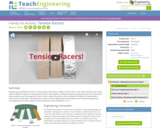
Learn how basic elements form molecules to support life.
A free CK-12 account is required to view all materials.
- Subject:
- Mathematics
- Science
- Material Type:
- Lesson
- Provider:
- CK-12 Foundation
- Provider Set:
- CK-12 Life Science
- Date Added:
- 10/02/2022

Learn how basic elements form molecules to support life.
A free CK-12 account is required to view all materials.

This lesson explores the drag force on airplanes. The students will be introduced to the concept of conservation of energy and how it relates to drag. Students will explore the relationship between drag and the shape, speed and size of an object.

Through three lessons and their four associated activities, students are introduced to concepts related to mixtures and solutions. Students consider how mixtures and solutions and atoms and molecules can influence new technologies developed by engineers. To begin, students explore the fundamentals of atoms and their structures. The building blocks of matter (protons, electrons, neutrons) are covered in detail. The next lesson examines the properties of elements and the periodic table one method of organization for the elements. The concepts of physical and chemical properties are also reviewed. Finally, the last lesson introduces the properties of mixtures and solutions. A comparison of different mixtures and solutions, their properties and their separation qualities are explored.

Students work as engineers to learn about the properties of molecules and how they move in 3D space through the use of LEGO MINDSTORMS(TM) NXT robotics. They design and build molecular models and use different robotic sensors to control the movement of the molecular simulations. Students learn about the size of atoms, Newman projections, and the relationship of energy and strain on atoms. This unique modular modeling activity is especially helpful in providing students with a spatial and tactile understanding of how molecules behave.

Organic chemistry is the study of the molecules that are necessary for life to exist. The key ingredient for these molecules is carbon, which is able to form complex structures and allows for the variety of different molecules in living things. This pathway provides resources for undestanding the basic rules that are used to categorize these different molecules.

Build a molecule in 3-D. Add single, double, and triple bonds, or a lone pair of electrons to an atom, learn what the molecule's geometric name is, see the bond angles, and manipulate each molecule to view it from all sides. Then study a collection of thirteen real molecules for comparison.

Students studying molecule shapes will better understand its concepts with this virtual experiment that tests how a molecule's shape changes due to repulsions between atoms. Learning is further enhanced by building molecules in 3D.

Watch different types of molecules form a solid, liquid, or gas. Add or remove heat and watch the phase change. Change the temperature or volume of a container and see a pressure-temperature diagram respond in real time. Relate the interaction potential to the forces between molecules.

Students learn about the basic principles of electromicrobiology—the study of microorganisms’ electrical properties—and the potential that these microorganisms may have as a next-generation source of sustainable energy. They are introduced to one such promising source: microbial fuel cells (MFCs). Using the metabolisms of microbes to generate electrical current, MFCs can harvest bioelectricity, or energy, from the processes of photosynthesis and cellular respiration. Students learn about the basics of MFCs and how they function as well as the chemical processes of photosynthesis and cellular respiration

Investigates compounds and their properties, the elements that form them, and their structure.
A free CK-12 account is required to view all materials.

Explores compounds and their properties, the elements that form them, and their structure.
A free CK-12 account is required to view all materials.

A narrated tutorial which helps illustrate the meaning of bond polarity. [1:51]

This interactive introduces how mistakes in the genome can cause disease. The gene editing tool CRISPR-Cas9 can correct these mistakes and potentially cure disease.

An interactive video lesson where students first determine misconceptions about what happens during chemical reactions, and then investigate some various chemical reactions.

Students learn that engineers develop different polymers to serve various functions and are introduced to selectively permeable membranes. In a warm-up activity, they construct models of selectively permeable membranes using common household materials, and are reminded about simple diffusion and passive transport. In the main activity, student pairs test and compare the selective permeability of everyday polymer materials engineered for food storage (including plastic grocery bags, zipper sandwich bags, and plastic wrap) with various in-solution molecules (iodine, corn starch, food coloring, marker dye), assess how the polymer’s permeability relates to its function/purpose, and compare that to the permeability of dialysis tubing (which simulates a cell membrane).

In an activity that integrates science and art, students see, experience and harness the phenomenon of surface tension as they create beautiful works of art. Students conduct two experiments related to surface tension floating objects on the surface of water and creating original artwork using floating inks. They also learn historical and cultural information through an introduction to the ancient Japanese art form of suminagashi. They take the topic a step further by discussing how an understanding of surface tension can be applied to solve real-world engineering problems and create useful inventions.

Students learn about the basics of molecules and how they interact with each other. They learn about the idea of polar and non-polar molecules and how they act with other fluids and surfaces. Students acquire a conceptual understanding of surfactant molecules and how they work on a molecular level. They also learn of the importance of surfactants, such as soaps, and their use in everyday life. Through associated activities, students explore how surfactant molecules are able to bring together two substances that typically do not mix, such as oil and water. This lesson and its associated activities are easily scalable for grades 3-12.

When molecules collide, chemical reactions can occur -- causing major structural changes akin to getting a new arm on your face! George Zaidan and Charles Morton playfully imagine chemical systems as busy city streets, and the colliding molecules within them as your average, limb-swapping joes. [3:25]

Students come to understand static electricity by learning about the nature of electric charge, and different methods for charging objects. In a hands-on activity, students induce an electrical charge on various objects, and experiment with electrical repulsion and attraction.

Students see how different levels of surface tension affect water's ability to move. Teams "race" water droplets down tracks made of different materials, making measurements, collecting data, making calculations, graphing results and comparing to their predictions and the properties of each surface, determining which surface exhibits the highest (or lowest) level of surface tension with water. They apply their results to make engineering recommendations for real-world applications.